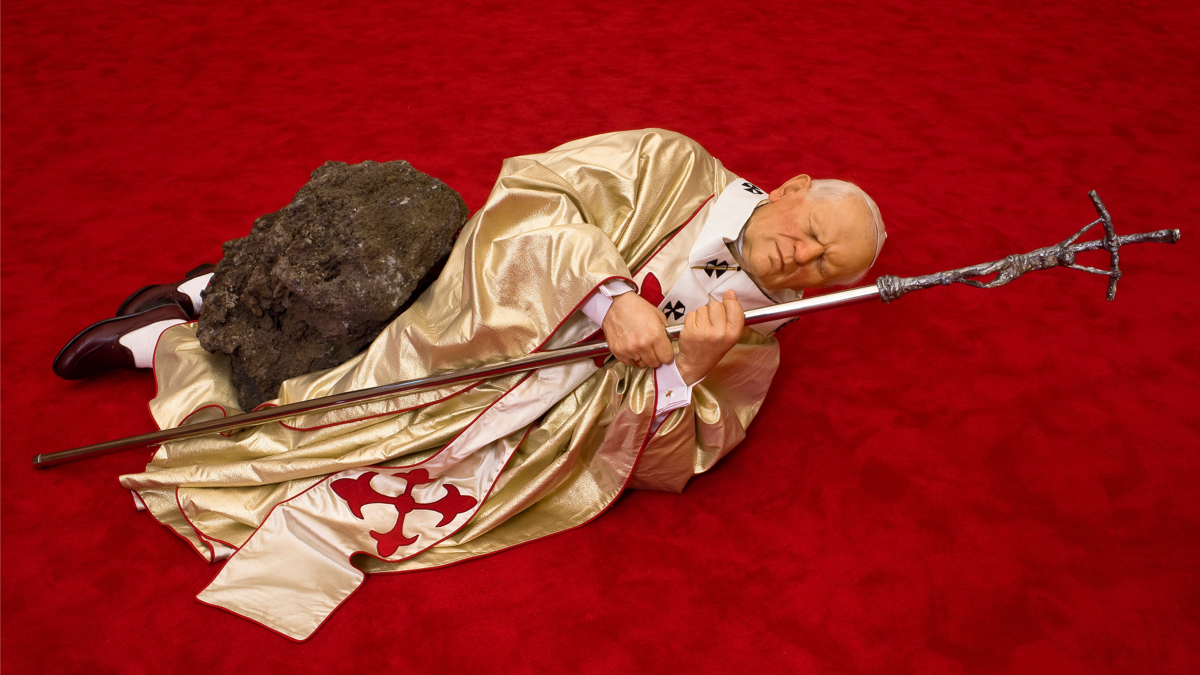
The 5 Most Frightening Depictions of Hell in Art
The 14th-century epic poem The Divine Comedy by Italian writer Dante Alighieri has influenced depictions of Hell throughout art history. The first part of the poem, titled Inferno, vividly describes Dante’s journey through the nine circles of Hell. These descriptions inspired many artists during the Medieval period and beyond, forming the basis of how Hell came to be envisioned in society.
Introduction: A historical and social construction of Hell
For the average person in the Middle Ages, eternal damnation in Hell was a real and dominant threat. The Catholic Church held a powerful influence over Western society, largely controlling its wealth, education, laws, and beliefs. By instilling in the population a fear of being sent to Hell, the Church ensured their committed faith and virtue.
Since the decline in power of the Catholic Church, depictions of Hell in art have continuously evolved to illustrate new and changing anxieties permeating society. During the Renaissance, fears of societal decline and change manifested themselves in grotesque and symbolic Hellscapes. Artists during the 20th century appropriated images of Hell to express the brutality of war and its impact on humanity. Today, representations of Hell take on new meanings. Artists around the world use its symbolic potential to tackle diverse themes, ranging from social injustices to the human psyche. Join us on a journey into the shadows, as we explore five of the most frightening, disturbing, and sometimes tragic depictions of Hell throughout art history.
1. The Mouth of Hell in The Hours of Catherine of Cleves
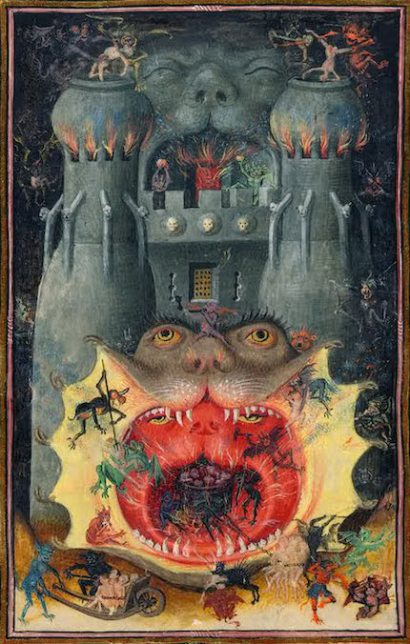
The Book of Hours is a Christian devotional book that was popular during the Middle Ages. When commissioned by wealthy patrons, its texts were often accompanied by elaborate and colorful illustrations called “illuminations.” This illumination of Hell marks the beginning of the “Office of the Dead” prayer cycle. Praying the The Office of the Dead was believed to reduce the punishment of the recently deceased in purgatory. In Christianity, this is a place where humans are purged of their sins before entering Heaven.
Maybe the most terrifying image in the book, this illustration offers a vivid depiction of the entrance to Hell, composed of three gaping monsters’ mouths. The Hellmouth, a popular image in Medieval art, was a portal between Earth and Hell surrounded by supernatural energy. Here, demonic creatures lead humans into the fiery pits of Hell, serving as a reminder to viewers of the brutal fate that awaited the sinful.
2. The Garden of Earthly Delights by Hieronymus Bosch
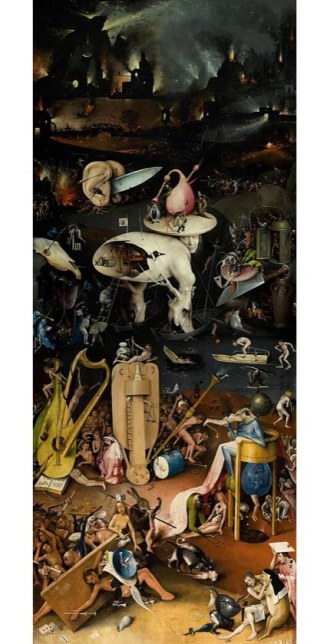
Around half a century later, in 1490, Dutch Renaissance artist Hieronymus Bosch started work on his triptych The Garden of Earthly Delights. Projecting the artist’s vision of the fate of humanity across its three panels, passing through an Edenic paradise and a land where humans indulge in sin, the work ends in this disturbing depiction of souls in Hell.
Bosch’s surreal and imaginative depiction of Hell draws from Dante Alighieri’s 14th-century Inferno. Both men shared similar beliefs about the inherent evils of humanity and its downfall in the face of sin. These beliefs were common during this period, and reflect the ingrained religious perceptions that dominated life in the Middle Ages. Dante warns about the consequences of giving in to sinful physical temptation in his poem, vividly describing the different levels of Hell that correspond to sins committed on Earth. In the “Hell” panel of Bosch’s triptych, the artist similarly warns viewers about the consequences of their actions on Earth by depicting punishments for each of the Seven Deadly Sins. A man vomiting symbolizes gluttony, one defecating gold coins symbolizes greed… Can you spot any others?
3. Dull Gret by Pieter Bruegel the Elder
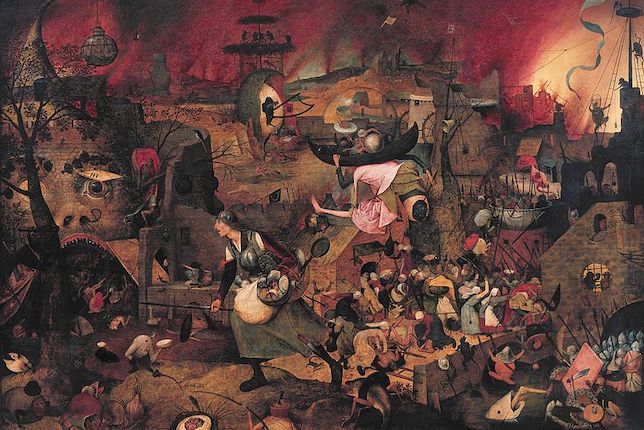
Another half-century later, Dutch artist Pieter Bruegel the Elder was producing paintings that combined depictions of peasant life and landscapes. He often incorporated themes of religion and proverbs into his work, like in this vision of Hell.
In the center of the image is Dull Gret, also known as Mad Meg, a figure from Flemish folklore whose greed drives her and a group of women to loot Hell. Possessing traits that were seen as undesirable for women in the 16th century, like being argumentative and ill-tempered, Dull Gret is a symbol of the fears surrounding powerful women during this period. An influence behind this work may have been the increase in powerful female monarchs in Europe at the time. This shift added to existing anxieties sparked by religious and societal upheaval. The idea of women grouping together was equally considered a threat to Western society, which has historically depended on patriarchal structures. One saying from a 16th-century Dutch book of proverbs highlights this fear, matching the sentiment of Bruegel’s painting:
“One woman makes a din, two women a lot of trouble, three an annual market, four a quarrel, five an army, and against six the Devil himself has no weapon.”
Women in the 15th to 18th centuries who possessed traits deemed “suspicious” or “undesirable,” like those of Dull Gret, were often suspected to be practicing witchcraft. Tens of thousands of people were killed in witch trials across Europe during this period, most of whom were women.
4. Peace, II by George Grosz
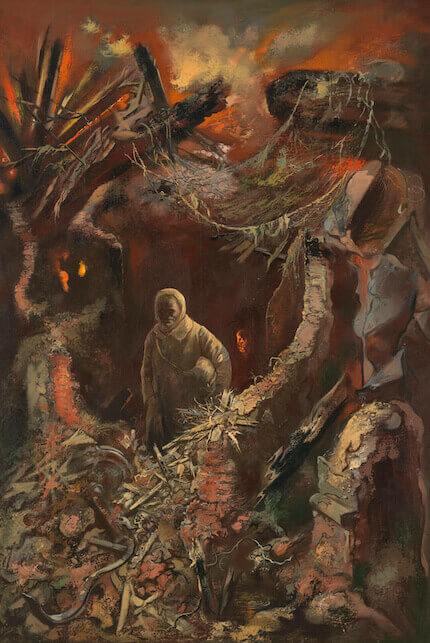
As the influence of religion declined in Europe, the concept of Hell began to adopt new roles and meanings. For some artists in the 20th century, representing Hell in art became a means of expressing the horrors of war. George Grosz was a German painter who lived through both world wars, witnessing these atrocities first hand. He fled Berlin when Nazis raided his studio in 1933, and his mother died soon after in a bombing raid.
Grosz produced numerous works during the 1930s and 40s. Using apocalyptic imagery, these works depict his vision of post-conflict Germany and highlight the impact of war on the individual. The figure in the center of his work Peace II is a self portrait of the artist, portraying himself as a survivor navigating through the remains of his destroyed homeland.
5. Scattered Deformities in the End by Fuyuko Matsui

In Buddhism, Hell is not a destination where souls are sent to be punished for eternity, but one of six states of existence that make up a recurring cycle of life. After death, beings are reborn into one of these six states depending on their actions throughout their life. The lowest of these states is known as the Hell realm.
Japanese artist Fuyuko Matsui is inspired by traditional depictions of this realm in Japanese art. Her works depict ghostly figures, flowers, and animals in fantastical settings, addressing themes of death and violence. A recurring motif in her work is the image of the mutilated or injured female body. This refers to a common depiction in Japanese Buddhist art of the decomposing woman’s body. These works traditionally served to deter monks from committing sins by averting their sexual desires. Matsui appropriates this image of the mutilated woman’s body in her work to deflect the gaze back onto the viewer, challenging the way that women are depicted and viewed in art.
Hell as a symbolic image in art…
Despite the changing role of religion in society since the Middle Ages, depictions of Hell have persisted as a powerful symbolic tool in art. While their initial function was to instill in the population a fear of eternal punishment for their sins, images of Hell have been appropriated throughout art history to visualize contemporary societal concerns and the horrors of war. These five artworks display some of the most disturbing depictions of Hell in art history, each expressing a different message… Can you think of any other examples?

About Artsper
Founded in 2013, Artsper is an online marketplace for contemporary art. Partnering with 1,800 professional art galleries around the world, it makes discovering and acquiring art accessible to all.
Learn more












